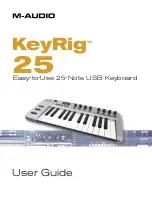
I. Overview/Features
This module is a keyboard, only mounted with your other modules in your modular synthesizer
rather than in a separate housing. It does this by using a small number of push-buttosn instead of
traditional keys. This can be used like a traditional keyboard to play melodies, or it can be used a
precision voltage reference for voltage controlled parameters in other modules.
CONTROLS
-Pitch select buttons. There are 12 buttons corresponding to a chromatic scale. They are arranged
like a typical keyboard with sharp/flat notes in a seperate row. Whenever two buttons are pressed at
the same time, the lower in pitch of the two will be output.
-Octave select knob. This knob selects which of five octaves the keyboard will output. There are 4
LEDs above the knob which give visual feedback for which octave is active.
-Slew knob. This knob adjusts the rate of slew/glide/glissando between notes. Fully
counterclockwise is no slew at all.
OUTPUTS
-CV output. This output goes from 0 to 5VDC in 1/12
th
volt intervals to corresond to the 1v/octave
standard commonly used in synthesizer modules.
-Trigger output. This is a short pulse output whenever a pitch select button is pressed. It alternates
between 0 and 5VDC
-Gate output. This pulses up whenever a pitch select button is pressed and remains high (5V) until
the button is depressed.
II. Schematic.
The schematic is on the next page. I'll briefly describe the different parts of the circuit to
help people understand the module. At the top center is the 16F689 PIC microcontroller (the PCB
has it labeled as a 16F685, this is a typo and should be ignored) which is the heart of the module.
On the far left, we see the octave display LEDs. Pin2 of the PIC is connected to the
cathodes of the red LEDs and the anodes of the green LEDs, so this allows it to control which set of
LEDs are active, by either being a current sink for the reds or source for the greens. Pin 13 controls
the anode of the first red LED and the cathode of the first green, and Pin 3 does this for the second
set. This allows us to control 4 LEDs with only 3 pins.
To the right of these, we see the switch matrix. Pins 14 through 16 are the outputs. And pins
4-7 are the inputs. When a single output pin is turned on, if any of the four switches that it is
connected to through the diodes is closed, then the corresponding input pin will read this. This
allows us to get 12 switches from only 7 pins.
Below the switch matrix to the left are the two potentiometers. Each is connected to +5V
and ground on it's outer lugs and it's wiper is connected to a pin on the microcontroller. The wipers
are also filtered by a .01uf capacitor. Slew is connected to pin 19 and Octave is connected to pin 18.
To the right of the switch matrix we see the gate and trigger outputs. Each of these consist
of a section of the TL074 op-amp wired as a unity gain buffer, the output of which goes through a
1K resistor to the corresponding output jack and a 1K current limiting resistor to an LED. The
trigger output comes from pin 10 and gate comes from pin 12.
Above these outputs we see the DAC and CV output circuitry. The 4921 is a serial digital-
to-analog converter (DAC). It receives data from the microcontroller on pins 2, 3 and 4 and then
outputs a corresponding voltage on pin 8. This voltage is then connected to a pair of inverting
amplifiers in series. The first has a trimpot in it's feedback path to fine-tune the output voltage.
Finally on the bottom we see the power supply connections. There are eurorack and MOTM
power connecter footprints, these are connected to a low pass filter of a 10 ohm resistor and 10uf
capacitor. The power rails go to the TL074 and a 7805 voltage regulator.
Содержание BMC038
Страница 3: ......
























